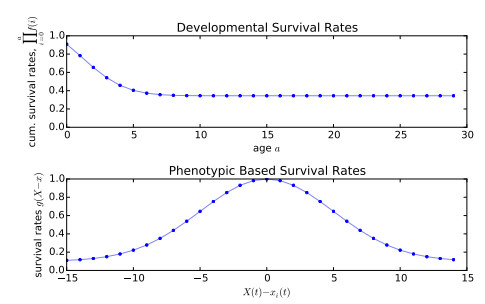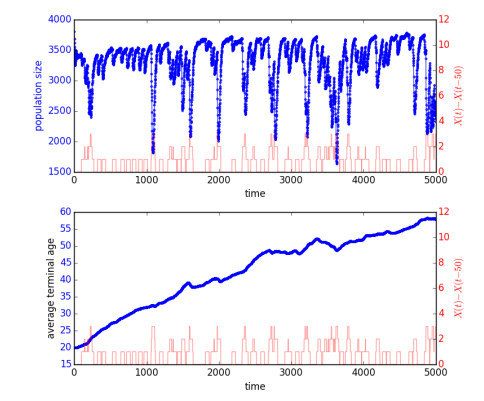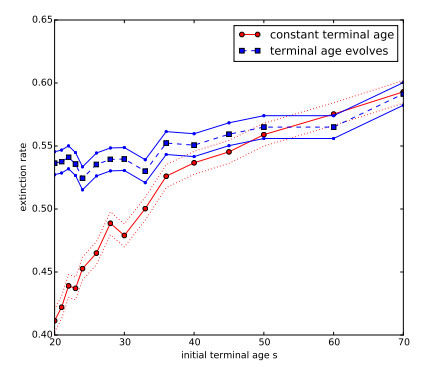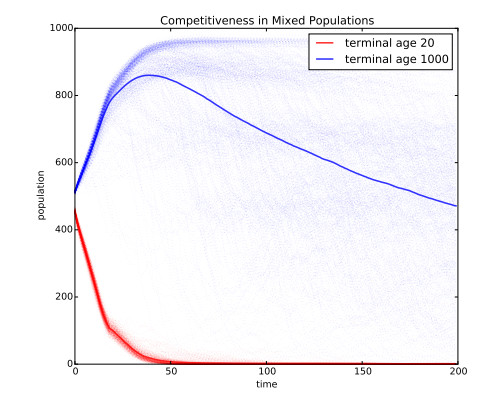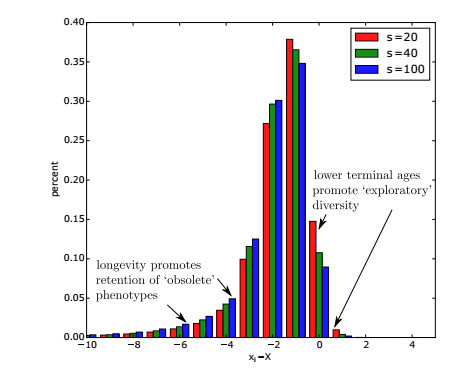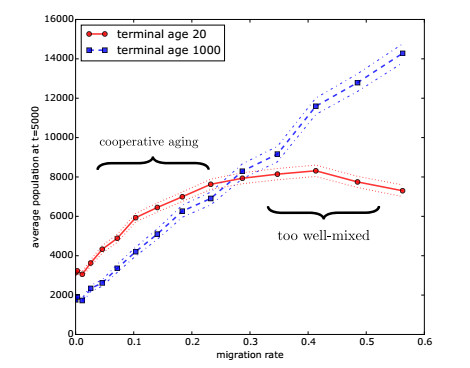Altruism is typically associated with traits or behaviors that benefit the population as a whole, but are costly to the individual. We propose that, when the environment is rapidly changing, senescence (age-related deterioration) can be altruistic. According to numerical simulations of an agent-based model, while long-lived individuals can outcompete their short lived peers, populations composed of long-lived individuals are more likely to go extinct during periods of rapid environmental change. Moreover, as in many situations where other cooperative behavior arises, senescence can be stabilized in a structured population.
1.
Journal summary from Editor in Chief
AIMS Allergy and Immunology is an international Open Access journal devoted to publishing peer-reviewed, high quality, original papers in the field of immunology and allergy. At the beginning of the new year and together with the Editorial Office of AIMS Allergy and Immunology, I wish to testify my sincere gratitude to all authors, members of the editorial board and reviewers for their contribution to AIMS Allergy and Immunology in 2024. We have made a meaningful progress in 2024, and we look forward to a more productive year in 2025.
In 2024, We received 36 manuscripts and 20 were published; these published papers include 11 Research articles, 4 Review articles, 2 Editorial, 2 Case report, and 1 Mini review. The authors of the manuscripts are from more than 10 countries. The data shows a significant increase of international collaborations on the research of allergy and immunology. It now is a significant presence in the academic publishing market. During this 2024 we had 33% rejection ratio and publication time (from submission to online) was 117 days, illustrating the strict and efficient review process.
We should be congratulated that after we got the first impact factor in 2023, our impact factor increased from 0.7 to 0.9 in 2024. This is inseparable from the efforts of the editorial board members. This is a further sign of the good work done in recent years.
In recognition of authors' expertise the Best Paper Award was launched by AIMS Allergy and Immunology and the manuscript “Toll-like receptor 9 is involved in the induction of galectin-9 protein by dietary anti-allergic compound fucoidan.” (AIMS Allergy and Immunology, 2023, 7(1): 24–39), and “Dietary and orally-delivered miRNAs: Are they functional and ready to modulate immunity?” (AIMS Allergy and Immunology, 2023, 7(1): 104–131) were the winner.
AIMS Allergy and Immunology editorial board has 74 members now, and 4 of which joined in 2024. We will continue to renew and accept dedicated researchers to join the Editorial Board in 2025. One of the important strategies of attracting high quality and high impact papers to our journal has been the calls for special issues. In 2024, 3 special issues were established.
The road is still long and winding but we hope that in 2025, with the support of all the members of the editorial board and reviewers, AIMS Allergy and Immunology can receive and collect more excellent articles to be able to publish. The journal will dedicate to publishing high quality papers by regular issues as well as special issues organized by the members of the editorial board. We believe that all these efforts will increase the impact and citations of the papers published by AIMS Allergy and Immunology.
Please feel free to let us know your opinions, we will follow your suggestions and make updates to improve AIMS Allergy and Immunology.
Prof. Marcella Reale, Editor-in-Chief
AIMS Allergy and Immunology journal
Dept. of Innovative Technologies in Medicine and Dentistry
University “G. d'Annunzio” Chieti-Pescara; Via dei Vestini, Chieti, Italy
2.
Editorial development
2.1. Manuscripts statistics
In 2024, AIMS Allergy and Immunology journal published 4 issues, a total of 20 articles were published online. The category of published articles is shown in Table 1. These published papers include 11 Research articles, 4 Review articles, 2 Case report, 2 Editorial and 1 Mini review. The journal received a total of 36 submissions (Figure 1). The number of submissions shows an upward trend, and the publishing number remains stable. The publication time (from submission to online) was 117 days, illustrating the efficient review process. In 2024, AIMS Allergy and Immunology places greater emphasis on publishing high-quality articles and hopes to receive more citations.
2.2. Author distribution
Figures 2 and 3 provide the counts of submitted and online manuscripts per country. The countrys are derived by affiliation of the corresponding author. In 2024, we received 36 submissions from 17 countries, which shows the diversity of the author distribution. We firmly believe that this widely distributed and powerful group has promoted the development of materials science.
2.3. Articles metrics
Compared with 2023, the impact factor of AIMS Allergy and Immunology has improved in 2024, which is of great significance for the development of our journal. The following are specific metrics of articles in the journal.
Table 2 shows the top ten manuscripts in terms of downloads and views in last two years. This will be a motivation for the future promotion of journals and to help them get into the desired databases as early as possible (Data from journal homepage as of December 23, 2024).
Table 3 shows the top five manuscripts in terms of citations in last two years. This will help us increase the visibility and impact of the journal (Data from Web of Science as of December 23, 2024).
2.4. New Special issue in 2024
In 2024, AIMS Allergy and Immunology has completed three new special issues. We hope that these three special issues will attract more high-quality submissions in 2025.
2.5. Editorial board members
AIMS Allergy and Immunology has Editorial Board members representing researchers from 20 countries, representing a diverse range of research experience, expertise and countries. We are constantly assembling the editorial board to be representative to a variety of disciplines across the field of allergy and immunology. AIMS Allergy and Immunology has 74 members now, and 4 of them joined in 2024 (Figure 4). Our EB members are mainly from the United States, Italy, Korea, Australia and Canada. We will continue to invite dedicated experts and researchers in order to renew the Editorial Board in 2025.
2.6. Summary & plan
2.6.1. Summary
In 2024, our journal developed smoothly. We have received 36 submissions and published 20 papers. The number of submissions increased in 2024 compared with 2023. The processing period (from received to published) and acceptance rate all remains stable. Each submitted article is processed carefully, fairly, promptly, and the accepted papers appear in the journal in the shortest time. In the past year, with the actively support of the guest editor, we have successfully we have successfully established three new special issues. In 2024, with the support of the editorial board members and the editor-in-chief, as well as the contributions of authors and reviewers, the impact factor for AIMS Allergy and Immunology increased from 0.7 to 0.9.
2.6.2. Plan in 2024
The goal for us to run this journal is to secure the best scientific authors and papers that ensures Allergy and Immunology to attract more citations and to stay at the forefront of professional publications in allergy and immunology, so that we provide the scientific community with a high-quality journal. In 2025, we expect to publish more articles to enhance the reputation: (1) We will invite more experts in the field of allergy and immunology to publish a review or research article. (2) We will increase influence by soliciting and advertising high quality articles and special issues (topics). (3) We seek to be indexed by more databases. (4) We will continued enlargement of the Editorial Board. (5) We will assign the Best Paper Award for 2024.









 DownLoad:
DownLoad:





